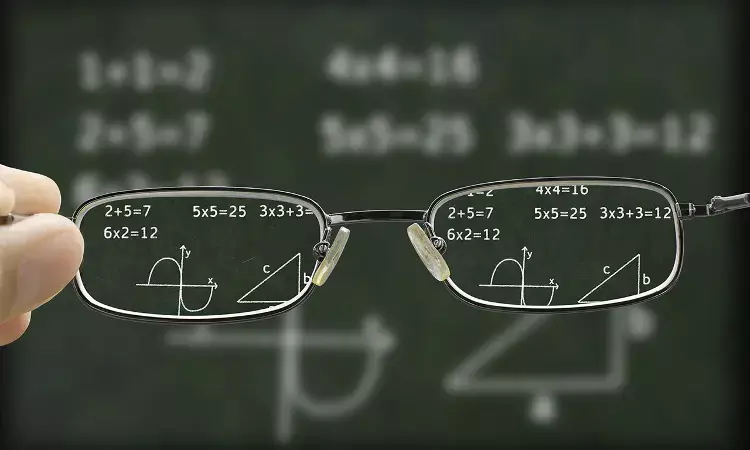- Home
- Medical news & Guidelines
- Anesthesiology
- Cardiology and CTVS
- Critical Care
- Dentistry
- Dermatology
- Diabetes and Endocrinology
- ENT
- Gastroenterology
- Medicine
- Nephrology
- Neurology
- Obstretics-Gynaecology
- Oncology
- Ophthalmology
- Orthopaedics
- Pediatrics-Neonatology
- Psychiatry
- Pulmonology
- Radiology
- Surgery
- Urology
- Laboratory Medicine
- Diet
- Nursing
- Paramedical
- Physiotherapy
- Health news
- Fact Check
- Bone Health Fact Check
- Brain Health Fact Check
- Cancer Related Fact Check
- Child Care Fact Check
- Dental and oral health fact check
- Diabetes and metabolic health fact check
- Diet and Nutrition Fact Check
- Eye and ENT Care Fact Check
- Fitness fact check
- Gut health fact check
- Heart health fact check
- Kidney health fact check
- Medical education fact check
- Men's health fact check
- Respiratory fact check
- Skin and hair care fact check
- Vaccine and Immunization fact check
- Women's health fact check
- AYUSH
- State News
- Andaman and Nicobar Islands
- Andhra Pradesh
- Arunachal Pradesh
- Assam
- Bihar
- Chandigarh
- Chattisgarh
- Dadra and Nagar Haveli
- Daman and Diu
- Delhi
- Goa
- Gujarat
- Haryana
- Himachal Pradesh
- Jammu & Kashmir
- Jharkhand
- Karnataka
- Kerala
- Ladakh
- Lakshadweep
- Madhya Pradesh
- Maharashtra
- Manipur
- Meghalaya
- Mizoram
- Nagaland
- Odisha
- Puducherry
- Punjab
- Rajasthan
- Sikkim
- Tamil Nadu
- Telangana
- Tripura
- Uttar Pradesh
- Uttrakhand
- West Bengal
- Medical Education
- Industry
Choroidal Changes Could Help in Predicting Future Myopia in Children, reports research

A new study published in the British Journal of Ophthalmology explored how short-term changes in the choroid may help predict the onset of myopia (nearsightedness) in children. Myopia is a common refractive error which has become increasingly prevalent among young people and early identification of children at risk could be critical for implementing preventive measures.
The research followed a total of 577 eyes from 289 primary school children over a period of 2 years. The study determined whether short-term choroidal changes could predict future myopic shifts which is defined as a significant refractive change of at least −0.50 diopter per year. At baseline, none of the children were classified as having myopia, and their eye measurements were recorded using optical coherence tomography (OCT). The measurements included cycloplegic refractions (used to measure refractive errors) at baseline, one year, and two years. Also, the study analyzed the choroidal thickness (ChT), luminal area (LA), stromal area (SA), and total choroidal area (TCA) at baseline and 3 months.
By the end of the two-year follow-up, a total of 228 children (455 eyes) completed the study. Among initially non-myopic eyes, 37.6% underwent a myopic shift. In contrast, 73.6% of initially myopic eyes showed a progression towards increased myopia. The study found significant differences in the choroidal changes between children who developed a myopic shift and the children who did not, particularly in initially myopic eyes. After 3 months, children who experienced a myopic shift expressed greater reductions in ChT, LA, SA, and TCA when compared to the children without a myopic shift. These choroidal changes were not significantly different between non-myopic eyes, regardless of whether a myopic shift occurred or not.
The multivariable analyses of this study revealed that each percentage increase in ChT, LA, SA, and TCA was associated with a decreased risk of myopic shift (all p<0.001) for initially myopic eyes. While similar patterns were observed in non-myopic eyes, the associations were weaker in comparison.
One of the most significant findings was that adding the 3-month percentage change in choroidal parameters to a predictive model (which already included age, gender, parental myopia, and baseline refraction) significantly improved the ability of the model to predict future myopic shifts in initially myopic eyes. The area under the receiver operating characteristic (ROC) curve, a measure of predictive accuracy, increased from 0.650 to approximately 0.800 (all p<0.05). However, this improvement was not seen in non-myopic eyes. Overall, this study suggests that short-term changes in the choroid may serve as early indicators of future myopic shifts in children who are already myopic.
Reference:
Wu, H., Liu, M., Wang, Y., Li, X., Zhou, W., Li, H., Xie, Z., Wang, P., Zhang, T., Qu, W., Huang, J., Zhao, Y., Wang, J., Zhang, S., Qu, J., Ye, C., & Zhou, X. (2024). Short-term choroidal changes as early indicators for future myopic shift in primary school children: results of a 2-year cohort study. In British Journal of Ophthalmology (p. bjo-2024-325871). BMJ. https://doi.org/10.1136/bjo-2024-325871
Neuroscience Masters graduate
Jacinthlyn Sylvia, a Neuroscience Master's graduate from Chennai has worked extensively in deciphering the neurobiology of cognition and motor control in aging. She also has spread-out exposure to Neurosurgery from her Bachelor’s. She is currently involved in active Neuro-Oncology research. She is an upcoming neuroscientist with a fiery passion for writing. Her news cover at Medical Dialogues feature recent discoveries and updates from the healthcare and biomedical research fields. She can be reached at editorial@medicaldialogues.in
Dr Kamal Kant Kohli-MBBS, DTCD- a chest specialist with more than 30 years of practice and a flair for writing clinical articles, Dr Kamal Kant Kohli joined Medical Dialogues as a Chief Editor of Medical News. Besides writing articles, as an editor, he proofreads and verifies all the medical content published on Medical Dialogues including those coming from journals, studies,medical conferences,guidelines etc. Email: drkohli@medicaldialogues.in. Contact no. 011-43720751


